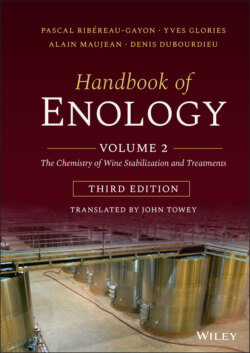Читать книгу Handbook of Enology, Volume 2 - Pascal Ribéreau-Gayon - Страница 9
Оглавление
FOREWORD
Over 70 years ago, in 1949, under the direction of Professor Jean Ribéreau‐Gayon, the first edition of Traité d'oenologie (Handbook of Enology) appeared. That publication aimed to gather scientific and technical knowledge in the main fields of science still in its early stages, originating from the works of Louis Pasteur. Later on, the book was regularly republished by integrating the most recent experimental results, especially those conducted at the Bordeaux School of Enology. In 1997, the fourth edition, published under the direction of Professor Pascal Ribéreau‐Gayon and Professors Denis Dubourdieu, Yves Glories, Aline A. Lonvaud, Bernard B. Donèche, and Alain Maujean, was completely reshaped into two volumes.
The current book, which is the seventh French edition (third in English) of the Handbook of Enology, updates and enriches the knowledge found in the two‐volume edition that first appeared 20 years ago. Subsequent editions were printed in 2004 and then in 2012. As Émile Peynaud said in Le Vin et les Jours, “…enology is at the service of wine, it is a science in movement, advancing both in its research and applications…” As an applied science, it is irrigated by knowledge from the fundamental sciences (chemistry, biochemistry, microbiology, bioengineering, psychophysics, cognitive psychology, etc.) and nourished by empirical observations. The approach used in the Handbook of Enology is thus still the same. It is about providing practitioners, winemakers, technicians, and enology students with solid knowledge and the most recent research results. This knowledge can be used to contribute to a better definition of the quality of grapes and wine, a greater understanding of chemical and microbiological parameters, with the aim of ensuring satisfactory fermentations and predicting the evolution of wines, and better mastery of wine stabilization processes. As a result, the purpose of this publication is to guide readers in their thought processes with a view to preserving and optimizing the identity and taste of wine and its aging potential. In other words, this publication was meant, as the late Professor Denis Dubourdieu wrote, to help “…obtain original products that are sufficiently complex, fine and appreciated by modern consumers…,” in a context where grape ripeness characteristics are evolving and greater attention is being placed on chemical additives.
The outline of this edition of the Handbook of Enology does not differ from the previous ones. Some of the chapters have been significantly reworked in light of recent research, while others have been changed only slightly or not at all. This is a collective work; it is the fruit of efforts by the researchers and professors of the Enology Research Unit at the Institut des Sciences de la Vigne et du Vin (ISVV), who provided their expertise to update this Volume 2:
Jean‐Christophe Barbe, Professor, Bordeaux Sciences Agro, researcher in the Enology Research Unit, ISVV, Université de Bordeaux (Volume 2, Chapter 2) regarding volatile esters;
Philippe Darriet, Director of the Enology Research Unit, Université de Bordeaux (Volume 2, Chapters 7, 8, and 13) regarding varietal aromas, off‐odors, and evolution of aroma during bulk aging of red wines;
Rémy Ghidossi, Professor, ISVV, Université de Bordeaux, researcher in the Enology Research Unit (Volume 2, Chapters 10–12) regarding winemaking practices and processes;
Axel Marchal, Professor HDR, ISVV, Université de Bordeaux, researcher in the Enology Research Unit (Volume 2, Chapter 13) regarding the evolution of taste components during bulk aging of wines;
Martine Mietton‐Peuchot†, Professor, ISVV, Université de Bordeaux, researcher in the Enology Research Unit (Volume 2, Chapters 10–12) regarding winemaking practices and processes;
Claudia Nioi, Enology Research Unit, ISVV, Université de Bordeaux (Volume 2, Chapter 13) regarding the dissolved oxygen assay and measurement of oxidation–reduction potential in wines;
Alexandre Pons, HDR researcher in the Enology Research Unit, ISVV, Université de Bordeaux (Volume 2, Chapters 7, 8, and 13) regarding varietal aromas, off‐odors, and evolution of aroma during bulk aging of red wines;
Sophie Tempere, Associate Professor, ISVV, Université de Bordeaux, researcher in the Enology Research Unit (Volume 2, Chapter 8) regarding psychophysical phenomena associated with the perception of off‐odors in wines;
Cécile Thibon, research engineer, INRAE, researcher in the Enology Research Unit, ISVV, Université de Bordeaux (Volume 2, Chapter 7) regarding varietal aromas.
The following persons also participated:
Michaël Jourdes, Associate Professor HDR, ISVV, Université de Bordeaux (Volume 2, Chapters 6 and 9) regarding polyphenols and colloidal phenomena in wines;
Stéphanie Marchand‐Marion, Associate Professor HDR, ISVV, Université de Bordeaux (Volume 2, Chapters 2, 3, 5, and 8) regarding alcohols, carbohydrates, certain nitrogen compounds, and compounds associated with off‐odors;
Pierre‐Louis Teissedre, Professor, ISVV, Université de Bordeaux (Volume 2, Chapters 1, 3, 4, 8, and 13) regarding several aspects of grape and wine composition (organic acids, carbohydrates, dry extract and inorganic matter, phenolic compounds) and the role of polysaccharides in the elimination of compounds causing wine spoilage.
